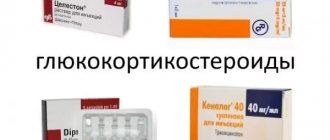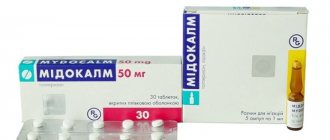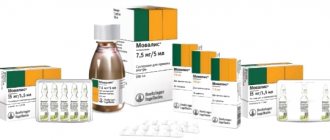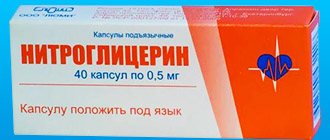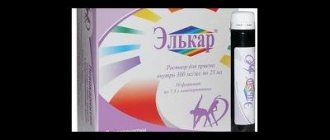The drug Fezam belongs to the group of psychostimulants and nootropics. It stimulates cognitive functions, has a positive effect on intelligence, and improves cerebral circulation. The drug is widely used in the treatment of many pathologies and its high effectiveness has been proven in practice.
pharmachologic effect
The abstract indicates that Phezam is a combined agent that provides nootropic, antihypoxic and vasodilating effects. There is a mutual potentiation of a decrease in cerebral vascular resistance, improving blood flow in these vessels.
As Wikipedia informs, the therapeutic effect and its mechanism are determined by the main active substances that are part of the drug Phezam. The main effect observed after taking the medicine is improvement of blood circulation in the brain and metabolic processes in nerve fibers and brain cells.
The substance piracetam has a nootropic effect, activating brain activity and positively affecting metabolism in the body. Under the influence of the substance, the rate of consumption of glucose, which is the main nutrient for the brain, increases. Thus, under the influence of piracetam, more active nutrition of cells occurs, which leads to the production of more energy and activation of brain function. Piracetam helps increase the speed of impulse transmission between neurons. As a result, memory increases, concentration improves, which leads to increased intellectual function.
Piracetam also helps improve blood flow in those areas of the brain where there are damaged vessels, and ischemia , that is, oxygen starvation. Since microcirculation improves, ischemic zones that arise due to lack of oxygen disappear, and the entire volume of neurons participates in brain function.
In addition, there is an indirect effect of this component, which helps to activate blood flow. It is ensured by inhibiting the process of platelet adhesion, which essentially prevents the formation of blood clots. The piracetam component not only activates blood flow, but also improves its properties. Thus, blood circulates more actively through microvessels.
hypoxia increases . Piracetam improves the integrative function of the brain, activates intellectual work, facilitates the process of assimilation of new material, and ensures restoration and support of brain functions in older people.
The substance cinnarizine has a pronounced effect directly on the blood vessels of the brain, dilating them. Also, under the influence of this substance, the tone of smooth muscles decreases, their response to active substances that constrict blood vessels decreases. Due to the fact that the substance dilates blood vessels, blood flow is activated, and more oxygen and nutrients enter the brain. Due to improved blood flow, the resistance of brain tissue to oxygen deficiency also increases. Moreover, despite the vasodilating effect, cinnarizine does not affect blood pressure and intracranial pressure .
The presence of these two components in Phezam simultaneously ensures a mutual enhancement of the effects of the active components. Consequently, the severity of the effect of the drug is more pronounced compared to taking these components separately.
When taking Phezam, there is a predominance of the sedative effect of cinnarizine, from which the medicine does not lead to the manifestation of psychomotor agitation, as happens when taking piracetam.
Phezam: effect of the drug
Phezam, the instructions for use emphasize this, has a pronounced antihypoxic, nootropic and vasodilating effect.
The active ingredient in piracetam is a nootropic substance. It activates blood circulation and metabolic processes in the brain. This allows you to improve memory, increase the threshold of intellectual fatigue and learning ability. In addition, piracetam provides protection to the brain during oxygen starvation, which minimizes the risks of damage and death of brain cells due to hypoxia.
Another active component, cinnarizine, has a vasodilating effect and reduces blood viscosity. This allows for improved tissue nutrition. The substance has moderate antihistamine activity, reduces the tone of the sympathetic nervous system and stimulation of the vestibular apparatus.
The drug is quickly and almost completely absorbed from the gastrointestinal tract. The maximum concentration of active components in the blood is reached in approximately an hour.
Pharmacokinetics and pharmacodynamics
After the patient has taken Phezam tablets orally, the active substances are completely absorbed from the gastrointestinal tract. The highest concentration of piracetam in plasma is observed after 2-6 hours, cinnarizine - after 1-4 hours. The bioavailability level of piracetam is 100%.
Piracetam does not bind to plasma proteins, cinnarizine binds 91%. Penetrates the BBB, is detected in all tissues and organs, and passes through the placental barrier. Its selective accumulation in the cerebral cortex is noted.
The substance piracetam is not metabolized, the metabolism of cinnarizine occurs in the liver.
The half-life of piracetam is 4-5 hours from the blood, 8.5 hours from the cerebrospinal fluid. Mainly excreted through the kidneys. The half-life of cinnarizine is 4 hours. Metabolites are excreted mostly in urine and also in feces. In people with renal failure, the half-life of piracetam is increased.
Pharmacological properties of the drug Phezam
The combination of piracetam and cinnarizine improves both blood circulation and the metabolism of neurocytes in the brain, auditory and visual analyzers, promoting the process of restoring their function. Both components mutually potentiate the effect aimed at reducing vascular resistance and increasing the resistance of neurocytes under ischemic conditions. The main mechanism of action is associated with improving metabolic and bioenergetic processes in the nerve cell, increasing the rate of turnover of information macromolecules and activating protein synthesis. Thanks to piracetam, ATP synthesis increases, oxygen utilization in the brain, the processes of glycolysis and protein synthesis improve; the metabolism of phosphatylcholine and phosphadylethanolamine increases; GABAergic, cholinergic and glutamatergic neurotransmission improves; The plasticity of the cell membrane increases during aging, lipid peroxidation processes are inhibited, and the rheological properties of the blood improve. Cinnarizine, by blocking the transmembrane transport of Ca2+ into the cell, reduces vascular tone, sensitivity to the vasoconstrictor effect of adrenaline, norepinephrine, bradykinin, improves the rheological properties of blood, increases the volume of regional blood flow without the occurrence of steal syndrome, increases the resistance of cells to hypoxia; does not affect blood pressure and heart rate, potentiates the anti-ischemic effect of piracetam. By preventing excessive overload of neurocytes, Ca2+ interrupts the rapid reactions of the glutamate-calcium cascade, which underlie damage to neurocytes. The combined drug is quickly and completely absorbed into the gastrointestinal tract. Cinnarizine reaches maximum plasma concentrations 1 hour after oral administration. Completely metabolized, binds 91% to blood plasma proteins. 60% is excreted unchanged in feces, residual amounts are excreted in urine in the form of metabolites. The maximum plasma concentration of piracetam is reached after 2–6 hours. It freely penetrates the blood-brain barrier.
Indications for use of Phezam
Before using the medicine Phezam, you should definitely take into account the indications for use. The drug is prescribed in the following cases:
- with insufficiency of blood flow in the brain (in the case of vascular atherosclerosis , during the recovery period after an ischemic or hemorrhagic stroke , with encephalopathy of various origins, after a TBI);
- in case of intoxication;
- in diseases of the central nervous system, in which there is a decrease in intellectual-mnestic functions, that is, deterioration of attention, memory, mood;
- with psychoorganic syndrome, in which signs of asthenia and adynamia ;
- consequences of traumatic brain injury;
- labyrinthopathy (tinnitus, dizziness, nausea and vomiting);
- asthenic syndrome associated with psychogenic origin;
- Meniere's syndrome;
- for the purpose of preventing migraine , kinetosis ;
- in the complex therapy of children who have a psychoorganic syndrome, which has led to low learning ability.
What does the drug treat?
Fezam, the instructions for use confirm this, is indicated for the treatment of various intellectual and cognitive disorders. It improves memory and the thinking process, promotes the development of attention. When taken, it is possible to reduce emotional negative reactions such as irritability and apathy.
The drug has proven its effectiveness in the treatment of pathologies caused by cerebrovascular accidents. Fezam is prescribed after:
- Traumatic brain injuries.
- Hemorrhages.
- Intoxication.
It is possible to improve the condition of patients with psychoorganic disorders when using Phezam. This group includes a number of diseases characterized by:
- Deterioration of intellectual abilities.
- Weakening of memory, which causes difficulty in remembering new information and activating previously learned information.
- Emotional instability, which is expressed by a sharp change in mood.
Other indications for use of the medicine:
- Encephalopathy, which is associated with metabolic disorders in brain cells.
- Meniere's disease, the symptoms of which are dizziness and progressive hearing loss.
- Cognitive disorders.
- Asthenic syndrome, a characteristic feature of which is increased fatigue, significantly worsening the quality of life.
- Arterial hypertension caused by increased blood pressure.
Phezam is also used for preventive purposes. Taking it reduces the risk of developing a migraine attack. In addition, it is possible to prevent various unpleasant reactions of the body to acceleration and weightlessness: dizziness and motion sickness.
Contraindications
Phezam should not be taken in the following cases:
- in severe forms of renal and liver failure;
- during periods of increased psychomotor agitation;
- with Huntington's chorea ;
- during pregnancy and breastfeeding;
- when the patient is under 5 years of age;
- with high sensitivity to the components of the product.
The medicine is prescribed with caution to those patients who have been diagnosed with Parkinson's disease , hemostasis disorders, impaired liver or kidney function, and severe bleeding .
Contraindications and drug interactions
The medicine has a number of prohibitions on taking it. These include hypersensitivity, allergies to components or excipients. It is also forbidden to drink the drug in case of severe renal failure, when creatinine clearance is less than 20 ml/minute.
Phezam will cause harm in case of liver failure, which is due to the peculiarities of processing and excretion.
Contraindications for treatment include Henington's chorea and a recent hemorrhagic stroke (therapy is possible only in the late recovery period). The drug is prohibited in conditions accompanied by severe psychomotor agitation; it can be prescribed only after the patient’s well-being has stabilized. You should also not take it:
- children under 5 years old;
- pregnant, lactating;
- in the presence of hereditary diseases - lactase deficiency, galactose intolerance.
Therapy for Parkinson's disease, increased intraocular pressure, and any form of kidney or liver dysfunction is carried out only under the supervision of a doctor. Fezam should be taken with caution for diseases of hemostasis and decreased blood clotting, regardless of how long this condition lasts.
Side effects of Phezam
The following side effects are possible during treatment:
- Nervous system: nervousness, feeling of drowsiness, hyperkinesia. In rare cases - headaches, dizziness , insomnia , ataxia , agitation, anxiety.
- Allergic manifestations: in rare cases - skin rash, dermatitis , swelling, itching, photosensitivity.
- Digestive system: severe salivation, nausea, vomiting, abdominal pain, diarrhea .
- Other manifestations: increased libido.
Phezam tablets, instructions for use (Method and dosage)
The instructions for use of Phezam, which are provided in the annotation for the drug, indicate that the medicine should be taken 1-2 capsules three times a day for one to three months. The duration of treatment depends on the severity of the disease. The drug is usually taken in courses - 2-3 courses annually.
Children over 5 years old are advised to take 1-2 capsules 1-2 times a day. Capsules are used for one and a half to three months. Capsules should be taken by swallowing them whole, without violating the integrity of the capsule. The tablet should be taken with half a glass of non-hot water.
Many users ask about capsules and how to take them - before or after meals. The instructions say that there is no particular difference in whether to take the product before or after meals. But it is optimal to drink capsules 20-30 minutes after eating. It is advisable to take the medicine at the same time every day.
Doctors warn that you cannot take the medicine for longer than 3 months - a break is necessary between courses.
Composition and form of the product
Phezam is a combination drug that is produced in tablet form. Active ingredients in the product:
- 400 mg piracetam.
- 25 mg cinnarizine.
Phezam tablets are available in the form of cylindrical hard gelatin capsules. Their contents are white powder. It may contain conglomerates, which, when pressed, also take on a powdery appearance.
Other ingredients are also used in the production of the drug. All of them are indicated in the instructions for use.
Interaction
Not all medications can be taken with Phezam tablets at the same time, so the interaction of this medication with other medications should be taken into account.
When taking medications simultaneously with Phezam that depress the action of the central nervous system, ethanol , tricyclic antidepressants , their sedative effect may increase.
When taking Phezam, the effect of nootropic and antihypertensive drugs is potentiated.
Vasodilator medications enhance the effect of Phezam.
Due to the presence of cinnarizine in the drug, the activity of hypertensive drugs .
When taking Phezam simultaneously, there is an increase in the activity of thyroid hormones , which can lead to tremor and anxiety.
Due to the antihistamine effect, cinnarizine can mask the manifestation of positive reactions in relation to factors of skin reactivity during skin tests. To avoid this effect, you must stop using the medication 4 days before such tests.
Phezam may enhance the effect of oral anticoagulants .
special instructions
If Fezam is prescribed to patients with impaired liver function, liver enzyme levels should be monitored.
The medicine activates the functions of thyroid hormones, which is why patients undergoing treatment may experience anxiety and tremors .
Since cinnarizine can cause drowsiness, during treatment you should drive carefully and work with precise and dangerous machinery.
When treating elderly people, it is necessary to regularly monitor kidney function indicators and, if necessary, adjust the dose.
Active components are able to penetrate the filter membranes of hemodialysis .
The medication should be avoided in case of porphyria .
When taking Phezam, a false positive result may occur during doping control in athletes, also due to the presence of iodine-containing dyes in the capsule shell. A false positive result may occur in the radioiodine test .
Since piracetam reduces platelet aggregation, it should be prescribed with caution when hemostasis is impaired in patients, as well as in conditions accompanied by hemorrhages. You should not take the medicine during complex surgical operations, with severe bleeding and a history of hemorrhagic strokes
Phezam can provoke irritation in the epigastric region; when used after meals, a decrease in the severity of gastric irritation may be observed, for which purpose the medicine should be used with caution in patients suffering from gastrointestinal diseases.
lactose as an auxiliary component .
Phezam's analogs
Level 4 ATX code matches:
Bravinton
Acefen
Carnicetine
Pyracesin
Nooclerin
Semax
Piracetam
Olatropil
Vinpocetine
Cerebrocurin
Cavinton Forte
Calcium hopantenate
Glutamic acid
Cephabol
Olanzapine
Cerebrolysate
Pramistar
Sidnocarb
Vinpotropil
Glycine Ozone
Phezam and its analogues should be prescribed by a doctor after an accurate diagnosis. Active components similar to those contained in the drug Fezam are included in the following drugs: Combitropil , Piracezin , Omaron , NooKam . The price of analogues depends on the manufacturer of the drug and its packaging.
Medicines also have a similar pharmacological effect on the patient’s body: Acefen , Vinpocetine , Demanol , Memotropil , Combitropil , Pantogam , Pyriditol , Cellex , Encephabol , etc.
Omaron or Fezam - which is better?
Omaron drug and has the same indications for use, contraindications and causes similar side effects. At the same time, the price of the drug Omaron is lower compared to Fezam.
On the issue of the use of Phezam in pediatric neurology
N
and over the past decades, there has been a steady increase in the number of children with pathologies of the nervous system.
According to WHO, up to 10% of children suffer from neuropsychiatric diseases
, 80% of which are of perinatal origin. At the rate of increase in pathology of the cerebral nervous system that is currently observed, there is every reason to believe that the proportion of healthy children at birth by 2015 will be reduced to 15–20%, and the proportion of newborns with congenital diseases will increase to 35%.
However, as the child grows and develops, diseases of the central nervous system may develop under the influence of exogenous factors, such as traumatic brain injury, neuroinfection, psychogenic stress, and somatic diseases.
In the structure of perinatal lesions of the central nervous system, a large proportion is occupied by minimal brain dysfunction
(50% of cases). Minimal brain dysfunction is the outcome of mild organic brain damage, against which various neurotic reactions, behavioral disorders, school learning difficulties, impaired maturation of higher brain functions, and various neurosis-like conditions are observed.
Having an erased clinical picture, minor brain dysfunction is often diagnosed late and therefore insufficiently treated, acquiring a progressive character with the growth of the body and under the influence of various factors. However, it is accessible to rehabilitation to a greater extent than severe forms of pathology.
Minor brain dysfunction acquires particular significance in early school and adolescence, when various syndromes of school and then social and labor maladaptation are formed.
As already indicated, one of the exogenous factors causing diseases of the central nervous system is traumatic brain injury at the stage of long-term consequences. The relevance of this problem lies in the frequency of occurrence of traumatic brain injury (up to 62% of head injuries occur before the age of 24 years, and half of them in children under 15 years of age) and the fact that even after a mild traumatic brain injury, residual effects are observed in 50% of victims.
The severity of both subjective and objective manifestations of long-term consequences of traumatic brain injury increases with decompensation of the post-traumatic process, which creates the preconditions for the formation of various diseases in adults.
These circumstances draw attention to the importance of carrying out earlier rehabilitation measures.
, since in childhood there are much more opportunities for restoring impaired functions than in adults.
The next relevant aspect of pediatric neurology is vascular disorders of the central nervous system.
, occurring in 4–5% of cases among all neurological pathologies in children. One of the variants of cerebral circulatory disorders is vegetative-vascular dystonia (VSD), which most often results from mild perinatal damage to the central nervous system or exposure to exogenous factors in early childhood and becomes syndromic in nature with minimal organic pathology of the brain.
Considering the polyetiology of vegetative-vascular dystonia, the difficulties that existed until recently in diagnosis and especially in adequate treatment of this vascular pathology of the central nervous system become clear.
In recent years, various aspects of the diagnosis and treatment of diseases of the nervous system in children have been intensively developed. This creates the prerequisites for the development of a preventive approach in pediatric neurology: the earlier the diagnosis is made, the greater the opportunity to prevent neurological disorders in older age.
In the complex treatment of nervous system pathology in children, drug therapy plays a fairly large role. Unfortunately, the use of a number of medications that correct the above disorders in children is limited or impossible due to the lack of pediatric forms, the presence of side effects, the unpredictability of the effect on the child’s body, etc.
Currently, this problem is being actively solved, and significant progress has been made in the development of new drugs. Phezam , which entered the Russian pharmaceutical market relatively recently.
(production ).
Phezam is a unique combination of two drugs - piracetam and cinnarizine, which enhances their therapeutic effect without increasing toxicity. It has a pronounced antihypoxic effect and effectively reduces cerebral vascular resistance with an increase in cerebral blood flow. At the same time, the side effects of these drugs are completely neutralized: on the one hand, piracetam reduces drowsiness and asthenia caused by cinnarizine, and on the other, cinnarizine completely relieves tension and insomnia, which often accompany taking piracetam.
This drug is officially approved for use in children aged 5 years and older, has a minimum of contraindications and adequate dosage. Unfortunately, in the literature available to us, we did not find data on the results of its use in children with diseases of the central nervous system.
In this article we present the results of the use of Phezam in children and adolescents with diseases of the nervous system, the relevance of which was discussed above.
At the MMU Children's Clinic No. 5, Saratov, 40 children aged 6 to 15 years were observed. The fact of a previous brain disease and its nature was determined based on a study of the anamnesis and data from official medical documentation.
Three clinical observation groups were identified:
1st group:
patients with consequences of perinatal damage to the central nervous system, minor brain dysfunction and hypertensive-hydrocephalic syndrome. There are 10 children in total between the ages of 13 and 15. Of these, 7 were girls, 3 were boys. The main complaints of the patients were: frequent headaches, sleep disturbances, fatigue, irritability, memory loss, decreased academic performance, and behavioral disorders.
Group 2:
children who suffered a closed skull injury with a concussion in the early recovery period - 11 boys and 4 girls aged 6 to 15 years. Main complaints: increased fatigue, irritability, poor sleep.
Group 3:
15 children with vegetative-vascular dystonia aged 10 to 15 years. Of these, 7 boys and 8 girls. The nature of VSD has not been established. Main complaints: recurring headaches, fluctuations in blood pressure, increased fatigue when doing schoolwork and physical activity.
In all 40 patients, the neurological status did not contain focal symptoms.
Treatment with Phezam was carried out on the principle of monotherapy, for two months, at a dose of 1 capsule 2 times a day, with a control visit once every two weeks.
For the first group of patients, the following results were noted: after 30 days of use, 3 patients (30%) had no significant clinical effect, 7 (70%) had normalized sleep, decreased fatigue and irritability, and decreased the frequency of headaches. After 60 days of admission, all 10 patients (100%) noted a subjective improvement in their well-being; there was a pronounced positive trend towards improving the quality of life, expressed in the normalization of sleep, stabilization of blood pressure, reduction in school maladaptation (based on assessments and information from class teachers), stabilization of nervous system. mental status.
In the second group of patients, the most striking effect was noted: in all 15 patients, by the 30th day of therapy, the condition improved, and on the 60th day, the symptoms of post-traumatic asthenia completely regressed.
In the third group, on the 30th day of therapy, clinical improvement was observed in 7 patients, on the 60th day, in 14, blood pressure stabilized, fundus vascular tone normalized, headaches stopped, and fatigue significantly decreased. In 1 patient with VSD of the hypotonic type, there were no pronounced dynamics (only a decrease in headaches was noted).
Thus, on the 30th day of taking the drug, an improvement in the condition was noted in 45% of patients, and on the 60th day, the pathological symptoms were practically eliminated in 95% of patients, and in 26% of them there was a complete recovery. From the above data it follows that our single administration of Phezam for a two-month course revealed its positive effect in the treatment of children with the specified pathology of the nervous system.
It should also be noted that Phezam was well tolerated by all patients; no side effects were noted; discontinuation of the drug due to intolerance or deterioration of well-being was not required in any of the patients.
conclusions
1. Taking Phezam is effective in treating children with minimal brain dysfunction, VSD and the consequences of closed craniocerebral injury.
2. To achieve a pronounced clinical effect, the drug must be taken over a 60-day course.
3. The drug is well tolerated, which makes it possible to widely use it in outpatient practice.
4. It is necessary to continue testing Phezam in pediatric neurology, both in outpatient and clinical practice, to study the possibility of its use in various pathologies of the nervous system in children and its effectiveness as a prophylactic agent.
Reviews of Fezam
Most often, reviews about Phezam on forums are positive, they talk about improving the condition of patients when taking this medicine. Users write that after taking it, memory normalizes, attention and performance improve. Also, under the influence of the medicine, stress and anxiety .
Similar positive reviews appear when capsules are used for children.
On forums where the drug Phezam is discussed, reviews from doctors are also often positive. However, there are also negative comments that the drug causes drowsiness, as well as the lack of positive effects during treatment.
Phezam price, where to buy
The price of Phezam capsules in Moscow is on average 270 rubles for 60 pieces. You can buy them at any pharmacy with a doctor's prescription.
The price of Phezam in Ukraine (Kyiv, Kharkov, etc.) is from 200 UAH. per pack 60 capsules.
- Online pharmacies in RussiaRussia
- Online pharmacies in UkraineUkraine
- Online pharmacies in KazakhstanKazakhstan
ZdravCity
- Fezam capsules 400mg+25mg 60 pcs.Balkanpharma/Zdravle HFZ
275 rub.order
Pharmacy Dialogue
- Phezam (cap. No. 60)Zdravlje
RUB 321 order
- Phezam (caps. No. 60) ZiO-Zdorovye CJSC
300 rub. order
show more
Pharmacy24
- Phezam No. 60 capsules Pharmaceutical and Chemical Industry, Zdravle AT, Serbia
199 UAH.order
PaniPharmacy
- Phezam capsule Phezam capsules No. 60 Bulgaria, Balkanpharma-Dupnitza
223 UAH order
show more
Description and principle of operation of the medicine
The drug Phezam is a combination drug that improves brain metabolism. Phezam is a prescription drug, available in capsules, the cost is 260 rubles for 60 capsules. (Serbia).
The active elements of Phezam are piracetam and cinnarizine in amounts of 400 mg and 25 mg, respectively.
The drug has antihypoxic, vasodilating, nootropic effects. Each component works in collaboration with the second, and at the same time has its own distinctive properties. Piracetam, as a derivative of gamma-aminobutyric acid and a nootropic, gives the following effects:
- improves memory and other cognitive functions - learning ability, attentiveness, mental performance;
- optimizes the metabolic processes of nerve cells;
- improves the quality of blood microcirculation;
- improves the rheological properties of blood, without causing a decrease in the tone of vascular smooth muscles;
- restores the elasticity of the walls of red blood cells and reduces their adhesion;
- optimizes connections between brain structures;
- protects brain cells from damage due to hypoxia and intoxication;
- improves blood flow in the ischemic zone.
Also, piracetam, due to blood thinning, prolongs the bleeding time, which must be taken into account when carrying out treatment. Cinnarizine is a selective calcium channel blocker that reduces the flow of calcium into cells, which prevents vasoconstriction and dilates arterioles. Cinnarizine has a particularly effective effect on the blood vessels of the brain, without affecting blood pressure. The substance helps restore blood flow in the ischemic area, and also has a positive effect on peripheral circulation.

